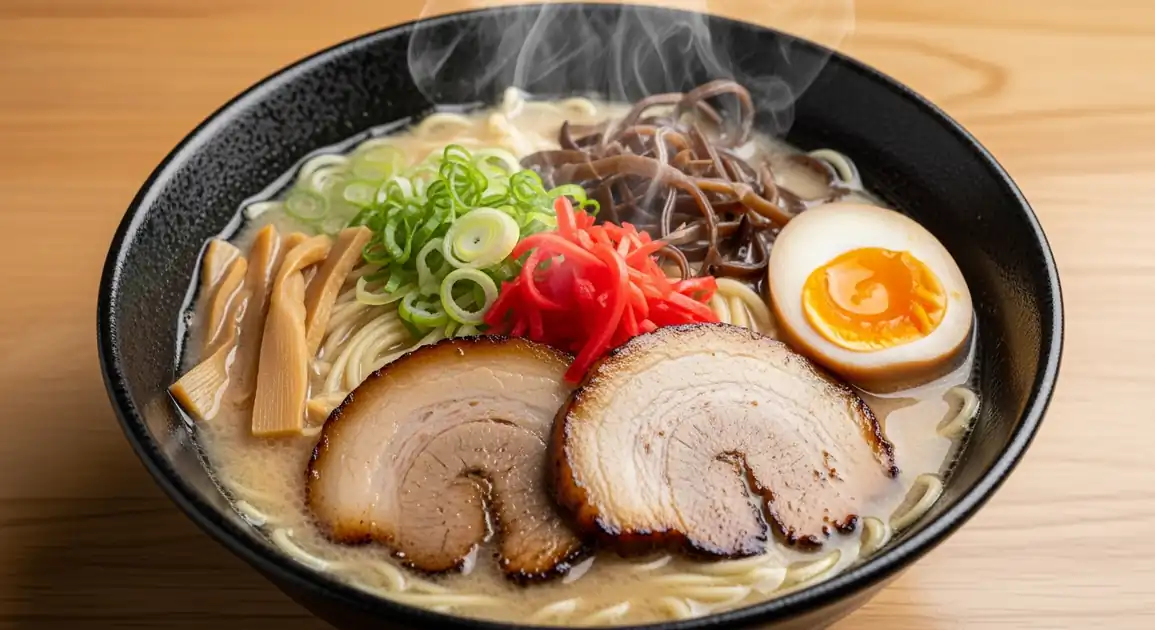Hakata Ramen
博多ラーメン

Description
Hakata Ramen originated in Fukuoka but is now one of the most popular ramen styles across Japan. You can find dedicated Hakata Ramen shops ('ramen-ya') in virtually every major city, as well as famous chain restaurants like Ichiran and Ippudo which have national and international presence.
Dietary Information
Serving information
Serving style
Served hot in a ramen bowl. Diners customize with condiments on the table (beni shoga, sesame seeds, garlic, karashi takana). Kaedama is ordered separately. Eaten with chopsticks and a soup spoon.
Quick facts
Highly variable. Lunch: 11 AM - 3 PM. Dinner: 5 PM - 10 PM. Many open continuously or very late (until 2 AM or later, especially in busy areas). Some specialized shops might only open for lunch or dinner.
Safety Tips
What to Look For
-
Shop/Stall Cleanliness
Check counters, floors, condiment containers, and staff hygiene. Yatai cleanliness is particularly important to observe.
-
Steaming Hot Broth
The broth should be served very hot, indicating it's freshly prepared and held at a safe temperature. This helps cook toppings like raw garlic if added.
-
High Customer Turnover
Especially for yatai, busy stalls mean ingredients are likely fresh and broth is constantly replenished/reheated.
-
Fresh Looking Toppings
Ensure toppings like chashu, negi, and eggs look fresh and are stored properly (e.g., refrigerated if prepared ahead).
-
Noodles Cooked to Order
Noodles are always cooked fresh for each bowl, ensuring proper texture and temperature.
What to avoid
-
Dirty or Poorly Maintained Shop/Yatai
Obvious lack of cleanliness in the eating area, kitchen, or around condiment station is a major red flag.
-
Lukewarm Broth
Broth served insufficiently hot may not be safe and indicates poor handling or preparation.
-
Old or Discolored Toppings
Avoid places where toppings (especially pork or egg) look dried out, discolored, or improperly stored.
-
Unpleasant Broth Smell
While tonkotsu has a distinct pork aroma, it shouldn't smell sour, rancid, or overly 'funky', which could indicate spoilage.
-
Visible Pests or Poor Waste Management
Presence of flies, rodents, or overflowing bins near the stall/shop suggests significant hygiene issues.
Price information
Price range
Budget tips
- Basic ramen bowls are usually under 1000 JPY.
- Ticket machines often clearly display prices.
- Kaedama (extra noodles) is cheap (100-200 JPY).
- Avoid excessive extra toppings if on a tight budget.
Value indicators
- Rich, flavorful, well-emulsified tonkotsu broth.
- Perfectly cooked noodles (to your specified firmness).
- Fresh, high-quality toppings (especially chashu).
- Good balance between broth, tare, noodles, and toppings.
Where to Find This Dish
Entertainment Districts
Areas like Shinjuku (Tokyo), Dotonbori (Osaka) have high concentrations of ramen shops open late.
Shinjuku Golden Gai, Dotonbori Canal
Lunch, Dinner, Late Night
Near Train Stations
Convenient locations for commuters and travelers often host many ramen options.
Tokyo Station Ramen Street, Kyoto Station Ramen Koji
Lunch, Dinner
University Areas
Often have good value ramen shops catering to students.
Takadanobaba (Tokyo)
Lunch, Dinner
Vendor Tips
- Use ramen ranking websites/apps like RamenDB or Tabelog for recommendations.
- Don't be afraid of small, counter-only shops; they often serve excellent ramen.
- Observe the chef's process if possible; focused, efficient work often indicates quality.
How to Order
Regional Variations
-
Ajitama Ramen
(味玉ラーメン)
Standard Hakata Ramen topped with a marinated soft-boiled egg ('Ajitsuke Tamago').
-
Chashu-men
(チャーシューメン)
Features extra slices of braised pork belly ('chashu').
-
Negi Ramen
(ネギラーメン)
Topped with a generous amount of extra chopped green onions ('negi').
-
Karashi Takana Ramen
(辛子高菜ラーメン)
Includes spicy pickled mustard greens ('karashi takana'), either as a topping or available as a condiment. Adds a pungent kick.
-
Modern Variations
(モダン博多ラーメン)
Some shops experiment with additions like black garlic oil ('mayu'), spicy miso paste, or different vegetable toppings, deviating slightly from the classic.
Cultural context
History
Originating in the Hakata district of Fukuoka city on Kyushu island after World War II, Hakata Ramen evolved from Chinese noodle soups. It was initially developed as quick, affordable, and filling food for workers at the fish market, served from 'yatai' (food stalls). The use of pork bones, readily available and cheap, defined its unique 'tonkotsu' broth. Its popularity spread nationally and globally, with famous chains like Ichiran and Ippudo originating from Hakata.
Local significance
Ramen is a cornerstone of modern Japanese food culture, representing comfort food, regional diversity, and culinary craftsmanship. Hakata Ramen is one of the 'big three' regional styles (along with Sapporo Miso and Kitakata Shoyu).
Eating customs
- Specify noodle firmness.
- Customize with table condiments.
- Finish your bowl relatively quickly, especially if people are waiting.
- No tipping.